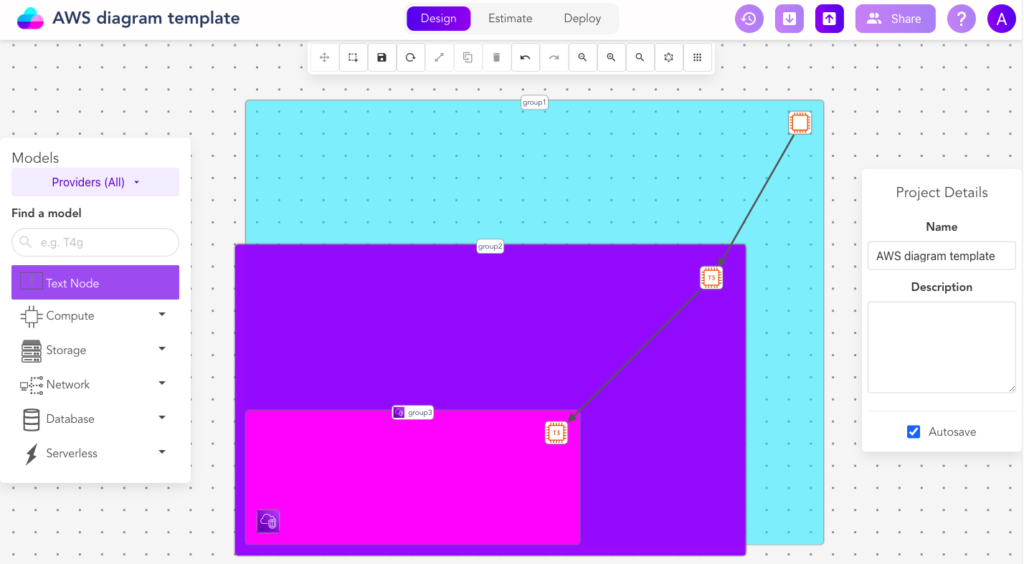Great AWS Templates available !
AWS Templates give a good starting point and best practices to design AWS diagrams.

An AWS Architecture Diagram Template communicates best practices for designing Amazon Web Services Architecture. It graphically displays a pre-built frame that you can iterate on. The AWS template has distinct icons, symbols, and arrows for planning, designing, or auditing an architecture before or after deployment. Using an AWS template is beneficial for Cloud architects and DevOps. Whether you are an expert or novice, it makes your work easier and faster because it offers you an idea of the future diagram you’ll be creating and saves you a lot of time in brainstorming.
Identify your objectives

First of all, you need to identify the objective and use cases of the project you want to set up. When you figure it out, then you can use an AWS template to have a general framework of your AWS infrastructure.
As you create your AWS infrastructure and set goals, the framework will guide your thinking and decisions. When you’re sure about your infrastructure and figured out the best configurations for it then you can plan and decide how your AWS services should interact with one another. Using this you can establish a list of the modifications in order to make the infrastructure more impactful and efficient for the objective or service you’re going to provide.
Why is it advantageous to use an AWS Architecture Template?
In a nutshell, the AWS Architecture Diagram Template helps you start on a project faster, it avoids starting from scratch every time. Especially when you may lack expertise for very specific topics, AWS templates give you a good starting ground that you can iterate on.
Similar to the official company PowerPoint framework, every employee must use within a company; DevOps and Cloud Architect may decide to create AWS templates that every future IT project must use. For example, any IT project must respect the same Security guidelines & policies within a company and Cloud Architects may have prepared AWS architecture templates every team member must use.
. Aside from that, the following are the additional advantages of the AWS Architecture diagram are:
- It allows you to have a quick overview of your full infrastructure.
- If there is an error that can be tracked easily
- Review and enhance security in the infrastructure
- Estimating the average and overall cost of the architecture

How to Use AWS Templates ?
To use the template you just need to sign up in your Holori account. Click on “New project” give it a name and click on the “template “ option. And you are all set. You can choose your preferred template to kickstart with. After choosing a template you can modify it according to your requirements. For example, you can remove unwanted components with just a click.
After that, you can add the components which are essential and not already included in the template. This way using a pre-built AWS template allows you to save up to 90% of your precious time.
Using the right template allows you to deploy all of the AWS resources required for an application at the same time. Templates are also very helpful because they are standardized and they need little modification as they are already designed according to specific use cases and by cloud architect experts.
What does an AWS template consist of ?
The following are the essential components of the AWS architectural system:
Cloud Resources Icons
The cloud icons represent the cloud resources such as Compute, Storage, Network, database etc. It also represents any service or general resources as well.
Symbols
Symbols are used for connecting and showing the relationship between the cloud resources. These shapes are not limited to – Lines, arrows, colors and connectors. These are used to improve understanding of various portions of the diagram that connect resources and describe the flow of information.
Groups / Availability Zones
The groups depict the relationship between many services or resources, or they can represent levels such as the data layer, service layer, and so on. A group can also represent a network zone.

Why designing AWS Architecture diagram is useful ?
AWS Architecture Diagram are frequently used by DevOps and IT professionals to overview and evaluate the cloud infrastructure which is going to be deployed to scale any business or organization. Amazon Web Services has put in a lot of effort to develop symbols and icons that symbolize various types of products and services. As a result, it is quite simple to recognize and comprehend each component of the AWS architectural diagram. It has made it much easier for DevOps and Cloud Architects to manage system architecture.
AWS Architecture Template Type
AWS 3-Tier Architecture Example
The most common multi-tier architecture implementation is the three-tier design. It has three tiers: the presentation tier, which is visible to clients/users also known as the user interface, the logic tier, often known as a server, and the data tier, which represents the database. This type of architecture is highly scalable and provides much flexibility.
AWS 2-Tier Architecture
In two-tier systems, the server is either hidden within the User Interface on the client or within the database or both.
AWS Elastic Load Balancer Network Diagram
As we know, load balancing is utilized to disperse traffic loads over multiple availability zones, and this architecture template is used for the same service. It divides the load of incoming traffic by using multiple EC2 instances.
